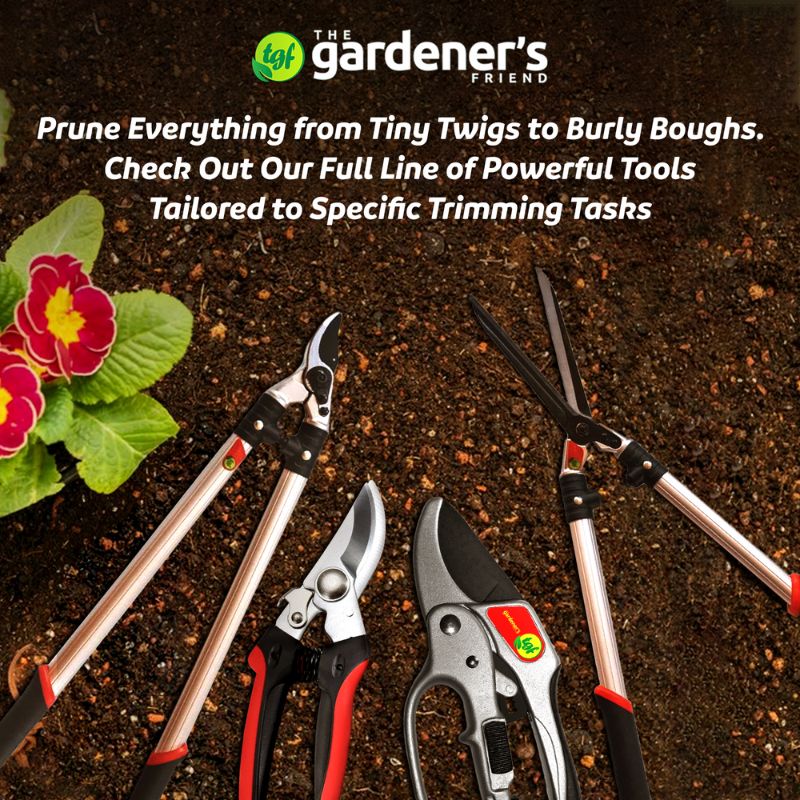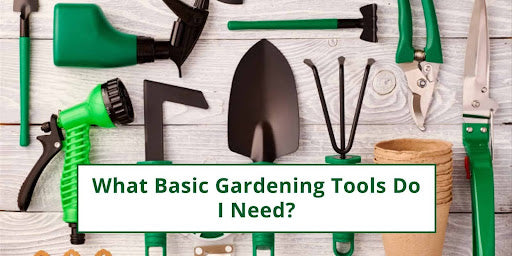If you want to start gardening, know that it doesn’t require a garage full of gardening tools.
A small set of well-chosen tools will streamline everything from prepping your soil to weeding and pruning.
In this guide, we’ll discuss:
- Which tools do you need to start gardening as soon as possible
- Why each of these tools matters
- And some of your burning questions
By the end, you’ll have a complete toolkit for starting and growing a garden.
Let’s get started.
Assess Your Garden and Goals
Before shopping, evaluate your garden.
For instance:
- If you want to grow herbs on your balcony, lightweight hand tools will do the trick
- A medium-sized shovel is what you need if you want to invest in raised beds
- Whereas, big in-ground vegetable plants will require a spade and garden forks
Define your goal first, and then match tools to the job.
Hand Tools
These are a must-have. Hand tools help with daily tasks like digging small holes, removing weeds, and loosening soil.
Trowel
A quality trowel has a broad steel blade that helps you dig planting holes and move soil precisely. It works well in tight spots where larger tools fail to perform. Look for a long blade with a comfortable handle/grip.
Hand Fork
A gardening fork has three or four sturdy tines that break up clumps, aerate the soil, and mix in compost. It’s ideal for shallow cultivation in containers and raised beds.
Digging and Soil Prep Tools
For digging your garden effectively and easily, you just need these two tools, at least in the beginning:
Spade
A spade has a square-edged, flat blade that creates clean bed edges. You can also use it to dig trenches for irrigation, define planting rows, transfer soil, and more.
Shovel
A shovel has rounded blades, making it ideal for scooping loose compost and soil. The tool has a sturdy shaft that gives you leverage to lift and move heavy material.
While shopping, pick a shovel with a pointed tip for easy penetration into dense soil.
Cutting and Pruning Tools
These are gardening tools that help you make clean cuts on plants so that they can regrow healthy parts.
Pruners (Secateurs)
There are three types of hand pruners: Bypass, anvil, and ratchet. Each one offers unique benefits, making it ideal for specific gardening tasks.
Bypass pruners work like scissors with two blades sliding across each other; they’re easier to use than scissors and make clean, healthy cuts on soft growth. Bypass pruners aren’t suitable for dead or dry wood.
Anvil pruners have a base (The anvil) on which the cutting blade falls. They’re ideal for dry wood and tough material, and can damage delicate stems.
Ratchet pruners have a special mechanism that lets you create clean cuts on tough materials with minimal hand force.
You May Also Like: Spring Gardening Checklist 101
Loppers
With long handles and blades, loppers help you cut material up to an inch in diameter. The extended handles give you more leverage, allowing you to cut higher limbs. Lightweight aluminum blades reduce the load on your arms, whereas steel ones are better performers.
Pruning Saw
This comes in handy when you have to trim branches over an inch thick. Pruning saws are generally of two types: Foldable ones are easier to store and carry around, while fixed-blade models offer better cutting power.
Watering and Irrigation Tools
Efficient watering offers two benefits: It keeps plants healthy and conserves water. Consider using both manual and automated tools.
Watering Can
Get a metallic or sturdy plastic watering can with a shower head. Manual watering is ideal for delicate seedlings and areas where the hose can’t reach.
Garden Hose
Get a kink-resistant hose with an adjustable spray nozzle. It will help you switch between mist, jet, and cone patterns to help you cover all watering needs.
Young plants need gentle misting, but to clean paths, you might need powerful jets of water.
Soaker Hoses and Drip Lines
Did you know you could deliver water directly to the roots of your plants automatically? All you need to do is lay soaker hoses at their base.
In addition, drip-irrigation systems use water emitting holes spaced according to plant needs. Both methods keep your soil moist.
Safety
Safety should be an important factor when selecting gardening tools.
Gloves
Gloves protect your hands from sap, dirt, sharp blades, and mud. Not only that, but they can make your tasks more convenient and, in turn, efficient. Just make sure you get the right kind of gloves for the job.
Knee Pads
If you have to kneel often while taking care of your plants, get knee pads. They’ll provide cushion and protect your knees.
Questions You Might Have
What Tools Do Beginner Gardeners Need?
Beginner gardeners need a handful of tools: A trowel for planting, a fork for soil aeration, pruners for trimming, a shovel for digging, and gloves for protection. Expand your tool set as your garden grows.
What is the Most Common Gardening Tool?
A hand trowel is probably the most common gardening tool. It helps you dig small holes, move soil, and apply fertilizers. Trowels are compact, versatile, and affordable, making them indispensable for amateurs and professionals.
How Often Should I Sharpen Gardening Tools?
You should sharpen gardening tools with cutting edges, such as pruners, shovels, and loppers, once a month, especially during growing seasons. Give them a one-time sharpening at the end of each season before storing.
When Should I Replace Garden Gloves?
Replace your garden gloves when you notice tears, holes, thinning grips, or excessive stains. High-quality gloves typically last for a season. If you perform heavy-duty tasks or work with chemicals a lot, you may need to replace them every couple of months.
Conclusion
With the right gear, gardening becomes more enjoyable and productive. If you’re new to it, start with the basics and get a tool set that covers your needs.
Gather tools that can help you plant, dig, cut, and water. Protect your hands and knees with proper gear. Gradually expand your toolkit as your garden expands.
Read More: How to Use Pruning Shears


